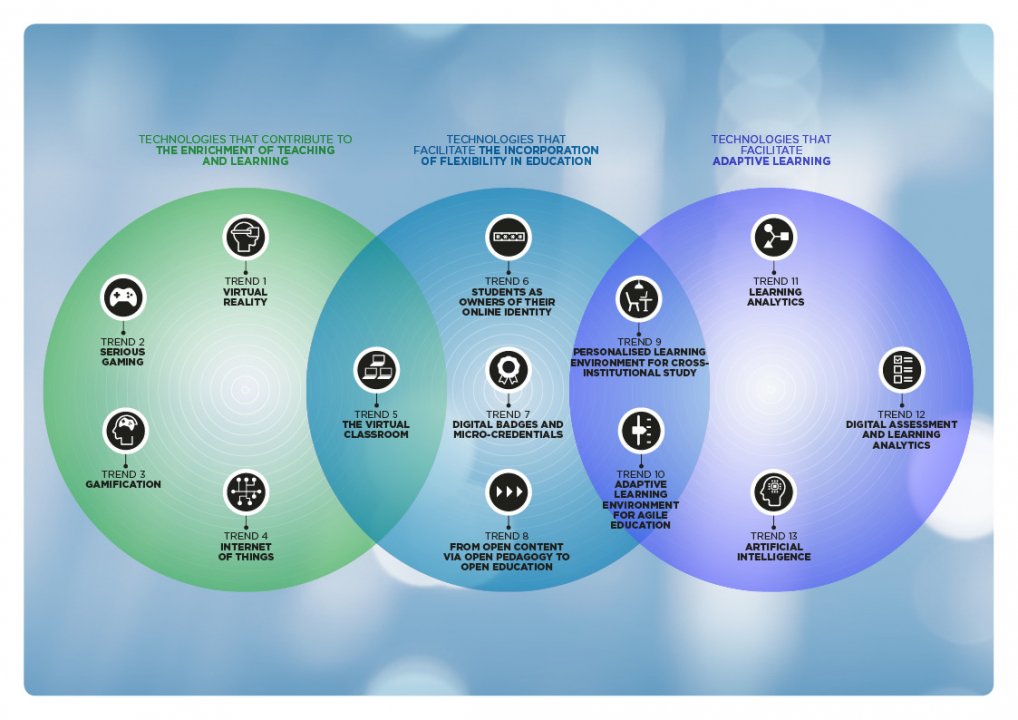Trendreport 2016: how technological trends enable customised education
On November 6th at the Dutch education days, SURF presented their trendreport. Since last week the report is also available in English. This trendreport focus on customised education.
SURF invited 44 Dutch experts, including three experts of TU Delft, to contribute to this report. This trend report describes 13 technological trends that may affect the content and design of education.
Thirteen trends
The trends:
- Virtual Reality
- Serious Gaming
- Gamification
- Internet of Things
- Virtual Classroom
- Student as owner of their own identity
- Digital Badges and micro-credentials
- From Open Content via Open Pedagogy to Open Education
- Personalised learning environment for cross-institutional study
- Adaptive learning environment for agile education
- Learning Analytics
- Digital Assessment and Learning Analytics
- Artifical Intelligence
Three Themes
The thirteen trends were grouped in three themes:
Didactic enrichment
Firstly, a number of trends lead to the enrichment of teaching and learning. Thanks to the sensory experience it provides, virtual reality can, for example, facilitate interactive learning in authentic learning situations. The same applies to the use of serious games. Gamification offers opportunities for providing feedback and encouraging self-management in that students can earn badges that act as milestones. Digital assessment allows students to obtain feedback immediately and gives them a better idea of their progress. The virtual classroom also enhances inter-active and collaborative learning without students and lecturers having to be physically present in a single location. Although many lecturers still regard a virtual classroom session as ‘nothing to do with them’, this learning technology, in conjunction with digital assessment, probably comes closest to the way we are used to learning within our education system. Rather than a drastic change, then, it is an improvement.
All in all, these technological trends are able to support key principles of effective education.
It is clear, however, that the quality of some technologies needs to be improved if they are to actually make education more effective and more attractive. For example, there is rather a large amount of variation in the quality of technology available for virtual classrooms. Meanwhile, VR applications that use ‘cardboard’ currently offer limited opportunities for interaction.
Organising flexibility
Secondly, we see the incorporation of flexibility in education, which ‘blurs boundaries’. Students are increasingly studying different programmes within the same institution, at different institutions (both within the Netherlands and abroad) and outside the traditional higher education system. They can follow programmes that incorporate open pedagogy and courses that are rewarded with microcredentials (such as massive open online courses). Micro-credentials and digital badges allow students to utilise the knowledge and skills they have acquired in different contexts. These technologies demonstrate that students have also developed their skills beyond the traditional education system. Students undergo a wide range of online and offline learning activities to develop an online education identity – in effect a personalised education number that they can use throughout their lives. The educational institution’s monopoly over the awarding of qualifications is definitely a thing of the past.
Adaptive learning
Thirdly, a number of technologies enable adaptive learning. This includes both highly advanced applications that could play a key role in the long term and technologies that enable a certain amount of ‘adaptivity’ in the short term. Artificial intelligence is an example of an advanced application. Here, students follow personalised learning paths based on the digital traces they leave in online learning environments. One example of a simpler application is digital assessment combined with learning analytics. Another example is the personalised learning environment that gives individual students access to the applications they use for learning purposes.
Download the report here. The report is published with an open license.
No feedback yet
Form is loading...
